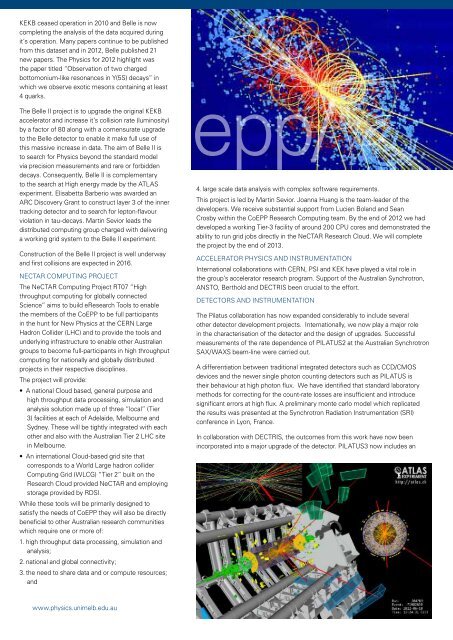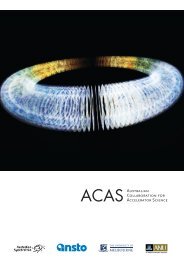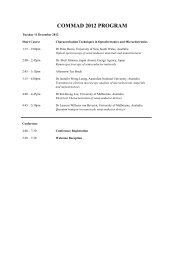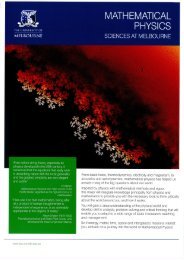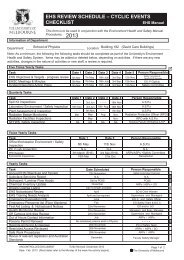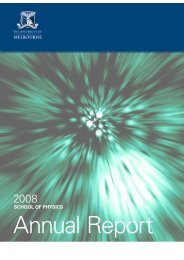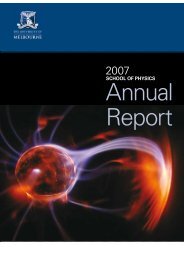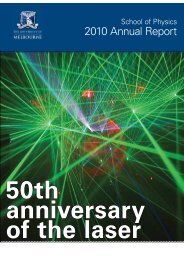Annual Report 2011-2012.pdf - School of Physics - University of ...
Annual Report 2011-2012.pdf - School of Physics - University of ...
Annual Report 2011-2012.pdf - School of Physics - University of ...
Create successful ePaper yourself
Turn your PDF publications into a flip-book with our unique Google optimized e-Paper software.
KEKB ceased operation in 2010 and Belle is now<br />
completing the analysis <strong>of</strong> the data acquired during<br />
it’s operation. Many papers continue to be published<br />
from this dataset and in 2012, Belle published 21<br />
new papers. The <strong>Physics</strong> for 2012 highlight was<br />
the paper titled “Observation <strong>of</strong> two charged<br />
bottomonium-like resonances in Y(5S) decays” in<br />
which we observe exotic mesons containing at least<br />
4 quarks.<br />
The Belle II project is to upgrade the original KEKB<br />
accelerator and increase it’s collision rate (luminosity)<br />
by a factor <strong>of</strong> 80 along with a comensurate upgrade<br />
to the Belle detector to enable it make full use <strong>of</strong><br />
this massive increase in data. The aim <strong>of</strong> Belle II is<br />
to search for <strong>Physics</strong> beyond the standard model<br />
via precision measurements and rare or forbidden<br />
decays. Consequently, Belle II is complementary<br />
to the search at High energy made by the ATLAS<br />
experiment. Elisabetta Barberio was awarded an<br />
ARC Discovery Grant to construct layer 3 <strong>of</strong> the inner<br />
tracking detector and to search for lepton-flavour<br />
violation in tau-decays. Martin Sevior leads the<br />
distributed computing group charged with delivering<br />
a working grid system to the Belle II experiment.<br />
Construction <strong>of</strong> the Belle II project is well underway<br />
and first collisions are expected in 2016.<br />
NeCTAR Computing Project<br />
The NeCTAR Computing Project RT07 “High<br />
throughput computing for globally connected<br />
Science” aims to build eResearch Tools to enable<br />
the members <strong>of</strong> the CoEPP to be full participants<br />
in the hunt for New <strong>Physics</strong> at the CERN Large<br />
Hadron Collider (LHC) and to provide the tools and<br />
underlying infrastructure to enable other Australian<br />
groups to become full-participants in high throughput<br />
computing for nationally and globally distributed<br />
projects in their respective disciplines.<br />
The project will provide:<br />
• A national Cloud based, general purpose and<br />
high throughput data processing, simulation and<br />
analysis solution made up <strong>of</strong> three “local” (Tier<br />
3) facilities at each <strong>of</strong> Adelaide, Melbourne and<br />
Sydney. These will be tightly integrated with each<br />
other and also with the Australian Tier 2 LHC site<br />
in Melbourne.<br />
• An international Cloud-based grid site that<br />
corresponds to a World Large hadron collider<br />
Computing Grid (WLCG) “Tier 2” built on the<br />
Research Cloud provided NeCTAR and employing<br />
storage provided by RDSI.<br />
While these tools will be primarily designed to<br />
satisfy the needs <strong>of</strong> CoEPP they will also be directly<br />
beneficial to other Australian research communities<br />
which require one or more <strong>of</strong>:<br />
1. high throughput data processing, simulation and<br />
analysis;<br />
2. national and global connectivity;<br />
3. the need to share data and or compute resources;<br />
and<br />
epp/<br />
4. large scale data analysis with complex s<strong>of</strong>tware requirements.<br />
This project is led by Martin Sevior. Joanna Huang is the team-leader <strong>of</strong> the<br />
developers. We receive substantial support from Lucien Boland and Sean<br />
Crosby within the CoEPP Research Computing team. By the end <strong>of</strong> 2012 we had<br />
developed a working Tier-3 facility <strong>of</strong> around 200 CPU cores and demonstrated the<br />
ability to run grid jobs directly in the NeCTAR Research Cloud. We will complete<br />
the project by the end <strong>of</strong> 2013.<br />
Accelerator <strong>Physics</strong> and Instrumentation<br />
International collaborations with CERN, PSI and KEK have played a vital role in<br />
the group’s accelerator research program. Support <strong>of</strong> the Australian Synchrotron,<br />
ANSTO, Berthold and DECTRIS been crucial to the effort.<br />
Detectors and Instrumentation<br />
The Pilatus collaboration has now expanded considerably to include several<br />
other detector development projects. Internationally, we now play a major role<br />
in the characterisation <strong>of</strong> the detector and the design <strong>of</strong> upgrades. Successful<br />
measurements <strong>of</strong> the rate dependence <strong>of</strong> PILATUS2 at the Australian Synchrotron<br />
SAX/WAXS beam-line were carried out.<br />
A differentiation between traditional integrated detectors such as CCD/CMOS<br />
devices and the newer single photon counting detectors such as PILATUS is<br />
their behaviour at high photon flux. We have identified that standard laboratory<br />
methods for correcting for the count-rate losses are insufficient and introduce<br />
significant errors at high flux. A preliminary monte carlo model which replicated<br />
the results was presented at the Synchrotron Radiation Instrumentation (SRI)<br />
conference in Lyon, France.<br />
In collaboration with DECTRIS, the outcomes from this work have now been<br />
incorporated into a major upgrade <strong>of</strong> the detector. PILATUS3 now includes an<br />
www.physics.unimelb.edu.au 17


